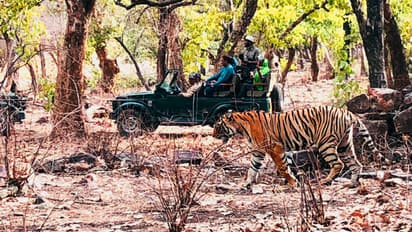
There are as many as 50 tiger reserves in India, but the one that never disappoints when it comes to sighting the beauty that is our national animal is the Ranthambore National Park. As a diehard fan of the feline king, I've ventured into this territory more than once, and each time has been a grand revelation that every Indian should experience at least once in his lifetime.
Ranthambore National Park, a place known for its high probability to spot tigers, is spread over an area of 392 sq km. Even before we had set foot on the train, there were talks and prayers about sighting the predator in its natural habitat. After boarding the SS Kota Express that goes from Hazrat Nizamuddin to Kota, my eyes were set on Sawai Madhopur that would lead me to my journey into the wild.
After seven hours of travel, I heard the first scream of excitement post the sighting of a wild animal from my two-year-old niece whose eyes had lit up after seeing a wild boar right on the railway station! While everyone joined in to celebrate with my niece, I was fixated on the one creature that mattered the most.
The excitement was at its peak as we were all set to go for the morning safari. Wrapped in layers of clothes in the morning chill, the anxiety while waiting in front of the main gate at the Ranthambore National Park was as palpable as waiting for the board results. The anticipation of which zone we would get assigned, where we could spot the tiger or whose alarm call to give more attention to inside the jungle were few thoughts that were racing through my mind. And luck! How could I forget to mention the most important thing that would play a major factor that day!
"Zone 4", announced the driver who would also be our guide for the next three hours. It was dawn. The birds darted across the sky in full morning spirit and 15 minutes into the jungle, I could feel the air so fresh as if my lungs were cleansed from all the city dirt that I had been inhaling for years. An hour-and-a-half into the journey and we had only spotted peacocks, wild boars, chimpanzees and some varieties of deer. While others seemed to lose hope, I hadn't.
It was in the evening, post lunch and a quick game of cricket that we were back for our second safari with the same zeal and vigour. This time it was zone 3. Touted as one of the prettiest zones, the area has several water bodies and due to that, the probability of sighting a tiger are relatively higher. Thirty minutes into the jungle, the driver asked everyone to keep their voices low as he heard an alarm call. When the predator is on the prowl, it is the common langur, sambar deer and peacocks that work as informants to each other. The first call we heard was from a peacock - less reliable but it was a step closer. That was backed by a sambar's call and it was almost certain that there was a tiger or a leopard nearby.
The alarm calls grew louder and so did our expectations. For almost an hour, we were fixated at a particular spot with our eyes wandering sharply. Finally, we saw the predator taking a stroll towards a pool where it could get some water. That lithe yellow and black painted a majestic portrait against the lush greenery of the forest. For the next hour, we followed its movements closely aboard our jeep, like devout disciples of a gallant guru.
The tiger, on close sighting, is a trusting creature as long as you give it its due space and calm. It may look your way, but nonchalant and kingly, it strides ahead athletically even with that royal 250-300 kg frame. A great yawner and frequent lapper of pool waters, the one that we spotted reminded us of all the wild fearlessness and grandeur that the nation itself stands for.
It is a matter of pride that the national park has reportedly seen the birth of 25 tigers over the past two years. The current population of tigers in Rajasthan has been declared at 85, including 70 in Ranthambhore, 14 in Sariska, and one in Mukundara Hills - a case of translocation.
Back from the safari, my cousin and I decided to get some beer from the shop nearby. We decided to walk the 1 km stretch without realising that the twilight would soon give way to pitch darkness.
Midway, we decided to hitch a ride as the narrow strip was covered by dense jungle on both the sides and the visibility was extremely low. We managed to hail a jeep and what happened afterwards left me speechless - while negotiating with the driver, there was movement about 15 metres ahead of us. Within a fraction of a second, a leopard leaped across, out of the bushes and into the other side of the jungle. The shy guy gave us quite a nano surprise; thankfully the national animal prevails as a longer, larger and generous sight!
"